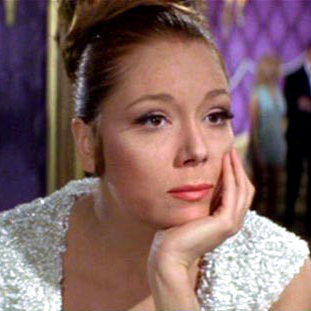
Jane Seymour is an English actress. After making her screen debut as an uncredited extra in the 1969 musical comedy Oh! What a Lovely War, Seymour transitioned to leading roles in film and television, including a leading role in the television series The Onedin Line (1972–1973) and the role of psychic Bond girl Solitaire in the James Bond film Live and Let Die (1973).

Fortune telling is the practice of predicting information about a person's life. The scope of fortune telling is in principle identical with the practice of divination. The difference is that divination is the term used for predictions considered part of a religious ritual, invoking deities or spirits, while the term fortune telling implies a less serious or formal setting, even one of popular culture, where belief in occult workings behind the prediction is less prominent than the concept of suggestion, spiritual or practical advisory or affirmation.

Diamonds Are Forever is a 1971 spy film, the seventh in the James Bond series produced by Eon Productions. It is the sixth and final Eon film to star Sean Connery, who returned to the role as the fictional MI6 agent James Bond, having declined to reprise the role in On Her Majesty's Secret Service (1969).

You Only Live Twice is the eleventh novel and twelfth book in Ian Fleming's James Bond series of stories. It was first published by Jonathan Cape in the United Kingdom on 26 March 1964 and sold out quickly. It was the last Fleming novel published in his lifetime. It is the concluding chapter in what is known as the "Blofeld Trilogy" after Thunderball and On Her Majesty's Secret Service.

A Bond girl is a character who is a love interest, female companion or (occasionally) an adversary of James Bond in a novel, film, or video game. Bond girls occasionally have names that are double entendres or puns, such as Plenty O'Toole, Holly Goodhead, or Xenia Onatopp. The female leads in the films, such as Ursula Andress, Honor Blackman, or Eva Green, can also be referred to as "Bond girls". The term Bond girl may also be considered as an anachronism, with some female cast members in the films preferring the designation Bond woman.

The Lovers (VI) is the sixth trump or Major Arcana card in most traditional Tarot decks. It is used in game playing as well as in divination.

Paul Huson is a British author and artist currently living in the United States. In addition to writing several books about occultism and witchcraft he has worked extensively in the film and television industries.

Live and Let Die is a 1973 spy film. It is the eighth film in the James Bond series produced by Eon Productions, and the first to star Roger Moore as the fictional MI6 agent James Bond. It was directed by Guy Hamilton and produced by Albert R. Broccoli and Harry Saltzman, while Tom Mankiewicz wrote the script. Although the producers had approached Sean Connery to return after Diamonds Are Forever (1971), he declined and a search for a new actor led to Moore being signed.

Live and Let Die is the second novel in Ian Fleming's James Bond series of stories. Set in London, the United States and Jamaica, it was first published in the UK by Jonathan Cape on 5 April 1954. Fleming wrote the novel at his Goldeneye estate in Jamaica before his first book, Casino Royale, was published; much of the background came from Fleming's travel in the US and knowledge of Jamaica.

Live and Let Die is the soundtrack to the eighth James Bond film of the same name. It was scored by George Martin. The title song was written by Paul and Linda McCartney and performed by Paul McCartney and Wings.

Teresa "Tracy" Bond is a fictional character and the main Bond girl in the 1963 James Bond novel On Her Majesty's Secret Service, and its 1969 film adaptation. She is the second Bond girl to marry 007, the first being in You Only Live Twice as an undercover ploy. In the film version, Tracy is played by actress Diana Rigg.

Tiffany Case is a fictional character in the 1956 James Bond novel Diamonds Are Forever and its 1971 film adaptation. A "Bond girl", she was portrayed by Jill St. John in the film. In the novel, the story of her name is that when she was born, her father Case was so embittered she was not a boy that he gave her mother a thousand dollars and a powder case from Tiffany's and walked out. In the film it is stated that she was named after her accidental preterm birthplace, Tiffany & Co., where her parents were going through a choice of wedding bands, to which Bond dryly jokes that she was lucky that it had not happened at Van Cleef & Arpels.
The Green Grotto Caves are show caves and a prominent tourist attraction on the north coast of Jamaica. Named for the green algae that cover its walls, the structure of the cave is strikingly different from inland systems; the cave is a Flank Margin Cave with two well-defined levels apparently indicating two periods with differing sea-levels. The innermost cavern contains a crystal-clear underground lake.
Inbaal is an Israeli-born British psychic and Wiccan Priestess. She has been seen on television programs such as Big Brother's Little Brother, House Busters and Most Haunted. She has also been Elle magazine's astrologer in the UK and has acted as guest astrologer for Elle magazine in Japan on several occasions.

Giacinta "Jinx" Johnson is a fictional character in the James Bond franchise, first appearing in Die Another Day, portrayed by Halle Berry.

All Esper Dayo! SP is a 2015 Japanese comedy-drama science fiction mystery television special directed by Sion Sono. It continues the story from the 2013 TV series adaptation of the seinen manga series Minna! Esper Dayo! written and illustrated by Kiminori Wakasugi. Sion Sono later directed a theatrical adaptation of the source material, released as The Virgin Psychics (2015).
Ross William Heilman, better known as Ross Kananga, was a crocodile farm owner and stunt man, best known for his appearance in the 1973 James Bond movie Live and Let Die.

The Awakening of Motti Wolkenbruch is a 2018 Swiss comedy-drama film directed by Michael Steiner. It was selected as the Swiss entry for the Best International Feature Film at the 92nd Academy Awards, but it was not nominated. It is based on Swiss author Thomas Meyer's debut novel, also called Wolkenbruch's Wondrous Journey into the Arms of a Shiksa.















